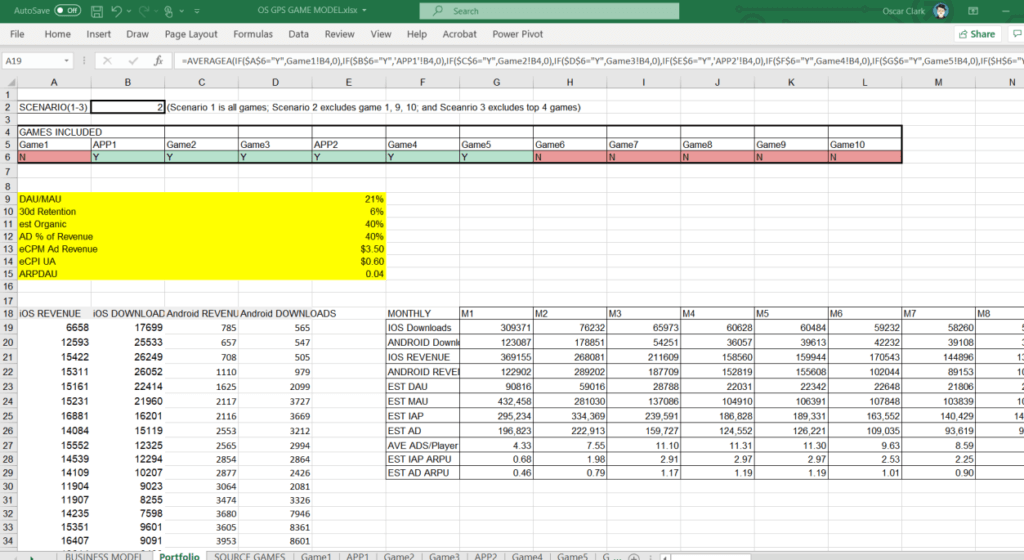Whether you are planning a new game or trying to work out why the game you launched isn’t performing as expected, one of the first things you need to confirm is whether this was a failure of the game or where there simply isn’t enough market potential for the concept. Trying to work out what success looks like is essential not only for investors, but also for your own purposes, so that you can understand the risk vs potential reward of your project. To answer this question, you need to build a model.
Editor’s Note: This is a guest post by Oscar Clark, Chief Strategy Officer at Fundamentally Games. Oscar Clark is a pioneer in social games services since 1998. Fundamentally Games LTD specialise in helping game developers deliver and operate living games, through LiveOps-as-as-service.
First, I should qualify that the approach I’ll be talking about in this article is what is often referred to as a revenue forecast, however we don’t use that term because you cannot really forecast how your game will perform without real player data from your game itself. However, you can use external data to see what success could look like and build a model on that basis, and over time, replace the external data with your own data, to deliver an actual revenue forecast.
Second, our intent in this article is to help you consider how to approach building such a model; we aren’t trying to create a tutorial here, but instead provide a framework which you can use to develop your own models in seven steps.
Step 1. Define Your Game’s Proposition
The first step is to really understand what your game is actually about, and by inference what market segment it seeks to satisfy. This is not just about genre. You need to consider what player ‘need’ your game is satisfying with an appropriate level of nuance. For example, Candy Crush, Puzzles and Dragons, and YMBAB all fit the match-3 genre, but their proposition is very different in terms of gameplay, branding, competitive position and player engagement, so just saying your game is match-3, is not sufficiently nuanced to position it effectively in the market.
It often helps to explore the key characteristics of the game from the core mechanic (how you play) to the context loop (sense of purpose and progression) as well as the metagame (the social and lifestyle fit). Add to that the art-style, narrative and commercial models and you will have a clearer idea of the proposition.
Step 2. Define Your Audience
Theoretically, you should define your audience first, but in practice it is more common that game developers will have a game proposition first and then match an audience to that game.
One approach to defining audiences is to use the idea of ‘Personas’, a common approach used by marketing teams in most industries. It means imagining your typical player, and defining what demographic data would apply to them. This includes age, gender, social classification (in the UK we use NRS Social Grade (https://en.wikipedia.org/wiki/NRS_social_grade). Then add to that some behavioural characteristics that can be used in targeting for example: ‘Plays Candy Crush’, ‘watches Game of Thrones’ and even give them a name to help put yourself in their shoes. Initially, this process is often a thought experiment. The idea is to create a hypothesis, an idea of who you expect audience to be, and identify characteristics to use in marketing. This can then also be used when looking at competitive games, as you can focus on those that also appeal to the same audience (as well as that match the game proposition).
At Fundamentally Games, when we are analysing a game for commercial potential, retention design or monetisation we tend to define 3 separate personas so that we can think not only who the game is designed for (Primary: Focused on Game Mechanic); the people who we believe the retention strategy is intended to attract (Secondary: Focused on Context Loop) and finally, the audience the game needs to attract in order to scale fully (Tertiary: Focused on Metagame).
So in an example, we may decide that Ahmed, 24, IT support and ‘self-confessed’ Gamer who thinks they could be an eSports player (C1, C2, D) is our primary audience.
It can be helpful to map out these persona types into what they Thinks, Does, Feels, Says as below:

Step 3. Find Competitor Games
Now that you have your game’s proposition and audience, you need to identify your most relevant competitors. For mobile, identify at least 10 games across the top Grossing Charts using tools like AppAnnie, or GameRefinery or AppMagic. Use these to filter games by genre/audience to find a variety of games with a range of Revenue and Download rankings. For PC titles, it takes a bit more manual effort to explore, for example SteamSpy, to find a suitable range of games. Remember that at this step, you are looking for competitor titles that most closely match the target market and audience you have identified.
The image below shows the kind of comparison you can do in GameRefinery where we have defined a market segment in terms of genre and sub-genre as well as platform and territory. We then chart the top ‘500 Sustained Grossing’ ranks against highest the top 1000 ‘Sustained Downloaded’ Rank what meet that criteria. This immediately gives us a shortlist of possible competitor games for us to explore and assess.

Depending on your game, you may need to consider target games from more than just one genre. For example, in a recent model that we built for a location-based game, we ended up also looking at exercise apps due to the specific nature of the game.
It’s worth making sure that you look closely at the games you are choosing, games which appear to offer similar features or target the same audience can turn out to be quite different in practice. Assess how relevant the comparisons are; this generally means playing them not just checking out some gameplay video. One tool for mobile games that can greatly speed up the research into competitors in GameRefinery is their ‘Powerscore’ metric. This gives you the ability to, at a quick glance, gauge the functional capability of different games so you can eliminate those which are not relevant without having to play everything.
Overall, you should be aiming to gather at least 10 games, with a relatively even mix of titles starting from the top 50 ranking down to around rank 500. It is important to identify a good range of games at different levels of performance, and to avoid overly stacking the model with high performing games. You also want to try to make sure that most of the games you pick have been on the market for a reasonable period of time as it’s hard to create a 3-5 year forecast if you only identify games which have only been on the market a few months.
Step 4. Extract Historic Data
Now you’ve chosen your competitor games, next up is to grab all the data you can for each of those games. You need a platform which will allow you to extract real data, ideally Revenue and Download numbers. For most platforms, this means you will need a premium account as the free options will not generally support this. On PC, use tools like SteamSpy, and we thoroughly recommend supporting that platform on Patreon in order to access a lot more detail than the general free version (it’s not expensive).
Pull all of the data into a spreadsheet, one tab per game, with a consistent layout that allows you to create a formula that compares revenue and download by platform from the first day of data of that game to the current date. The games you have selected will have been on the market for different lengths of time; but that’s ok because you should be looking at the average adoption rate across them all.
Step 5. Conditional IF(X,Y,Z) and AVERAGEA(A1:A9)
Without wanting to scare people off who are unfamiliar with the use of IF() in spreadsheets, believe me, these are your friend when creating a model. Set up a portfolio sheet using ‘AVERAGEA’ to take the data from each of the games you have imported, and build up a picture of the average of all the selected games from their first day. AVERAGEA ignores missing data which means that average doesn’t immediately break if one of your game happens to only have been live for a limited period.
But, to create different scenarios (e.g. low/moderate/optimistic) you can go one step further and in the Portfolio sheet, create some conditional boxes to show which game to include in each different scenario. Typically, Scenario 1 includes all games you imported, Scenario 2 includes all games except the top two; and Scenario 3 only includes the lowest 6 games. It does make the formula equation to consolidate your game data look a bit scary, but by putting this on a portfolio page you can adjust the game data independently (just do it carefully!).
I’ve included a screengrab of our Portfolio Tab to help you visualise what this looks like:

Step 6: Making Assumptions
Now we have data for the games, and a method to show the scenarios, you can turn this into a view of what revenue returns you could get for our game. You will need to decide what assumptions you need to include.
Unfortunately, data isn’t available about what advertising spend took place for these games, so you will have no idea about what level of Organic users vs Paid users there are. This varies per game, game but a recommended approach is to use some assumptions. We often start with the assumption of 40% Organic users. Similarly, you won’t know the cost of install (CPI) per game, so again making an assumption is your best bet. CPI varies greatly between game types and scale, from Hypercasual games looking for below $0.50, to games in highly competitive segments where the CPI may be multiple $. For PC games, CPI might be $20 or more in terms of direct paid user installs (SIDENOTE: PC game ads have a different objective in mind than direct installs and tend to be more about brand building which means that it doesn’t make sense to think of them just in terms of Cost Per Install).
Step 7: Add things up
The next step is to simply add up the daily revenue, downloads and whatever other data you have aggregated and apply your assumptions to get the results per month. You will want to consider if you are creating a 3 or 5-year model. 5 years may seem crazy in a practical sense but it may be necessary to satisfy certain investors. This does of course require that you have extracted sufficient historic game data that goes that far back or that you can confidently extrapolate.

Then create another tab (yes, yet another) to create a clean summary of the output. On this tab, make sure to have applied any currency conversion needed (e.g. if you are UK based you usually need to show your model in £GBP rather than $USD (most of the data comes in $USD). You then need to apply any sales taxes – which whilst this will vary per country, an assumption of 20% is usually a good start. Then you apply the platform fees to just the IAP proportion of your estimated revenues.
That gives you your revenue breakdown; to which you need to add your costs including staff,
expenses, etc. We tend not to include non-VAT taxes in our models because that gets into
complexity territory best left to your accountant.
Finally, we create a box which shows the following attributes by year with a cumulative 3 or 5 year
total:
• Total Downloads;
• TotalRevenue;
• Revenue Minus VAT;
• Revenue Minus Platform
• Total Costs (sometimes UA Spend as well)

In Summary
Building a model to show what success could look like for your game is about finding ways to validate your assumptions with as much real, relevant data as possible. Most of the time you will need to rely on external data from real world games. However, your model isn’t just something for investors. It is a useful tool for you to use as a baseline for your success. Take this model and replace your assumptions with real data from your actual game as soon as you can and see how you game performs compared to what you though it should be able to achieve – and compared to its competitors. That’s how you know what real success looks like.
About Fundamentally Games
Fundamentally Games Ltd was founded in 2019 by Ella Romanos and Oscar Clark. We help developers and organisations transform their games into living games and get more players, doing more things, more often, for longer. www.fundamentally.games





















